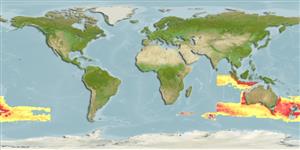Classification / Names
Common names | Synonyms | Catalog of Fishes (gen., sp.) | ITIS | CoL | WoRMS | Cloffa
Actinopterygii (ray-finned fishes) >
Lophiiformes (Anglerfishes) >
Oneirodidae (Dreamers)
Etymology: Oneirodes: Greek, 'oneiros' = a dream or dreamlike or out of a dream (suggesting this fish is so strange and marvelous that can exist only in dreams) (Ref. 86949).
Environment / Climate / Range
Ecology
Marine; bathypelagic; depth range 960 - 1132 m (Ref. 86949). Deep-water, preferred ?
Indo-West Pacific: New Zealand and Tasmania.
Size / Weight / Age
Maturity: Lm ? range ? - ? cm
Short description
Morphology | Morphometrics
Dorsal
soft rays
(total): 5;
Anal
soft rays: 4. Characterized by having escal morphology: large internally pigmented anterior appendage, its width nearly equal to that of illicium, length including terminal filaments greater than 22% SL; unpaired, highly filamentous medial escal appendage arising from base of terminal escal papilla; short, cylindrical posterior escal appendage; subopercle without indentation on posterodorsal margin; length of ventral fork of opercle 27.6-31.4% SL; ratio of lengths of the dorsal and ventral forks of opercle 0.45-0.47; absence of epibranchial teeth; well toothed pharyngobranchial II; upper jaw teeth 27-34, lower jaw teeth 34-42; teeth on vomer 6; dorsal fin rays 5; anal fin rays 4; pectoral fin rays 16-17; head length 41.4-48.6% SL; head depth 44.0-51.4% SL; head width 31.0-42.9%SL; premaxilla length 34.4-36.6% SL; length of lower jaw 45.6-48.6% SL; length of illicium 16.4-27.1% SL (Ref. 86949).
Life cycle and mating behavior
Maturity | Reproduction | Spawning | Eggs | Fecundity | Larvae
Eschmeyer, W.N. (ed.), 2001. Catalog of fishes. Updated database version of December 2001. Catalog databases as made available to FishBase in December 2001. (Ref. 40966)
IUCN Red List Status (Ref. 115185)
CITES (Ref. 94142)
Not Evaluated
Threat to humans
Harmless
Human uses
More information
Common namesSynonymsMetabolismPredatorsEcotoxicologyReproductionMaturitySpawningFecundityEggsEgg development
Age/SizeGrowthLength-weightLength-lengthLength-frequenciesMorphometricsMorphologyLarvaeLarval dynamicsRecruitmentAbundance
ReferencesAquacultureAquaculture profileStrainsGeneticsAllele frequenciesHeritabilityDiseasesProcessingMass conversion
Tools
Special reports
Download XML
Internet sources
Estimates of some properties based on models
Phylogenetic diversity index (Ref.
82805): PD
50 = 0.5000 [Uniqueness, from 0.5 = low to 2.0 = high].
Bayesian length-weight: a=0.01000 (0.00244 - 0.04107), b=3.04 (2.81 - 3.27), in cm Total Length, based on all LWR estimates for this body shape (Ref.
93245).
Trophic Level (Ref.
69278): 3.9 ±0.7 se; Based on size and trophs of closest relatives
Resilience (Ref.
69278): High, minimum population doubling time less than 15 months (Preliminary K or Fecundity.).
Vulnerability (Ref.
59153): Low to moderate vulnerability (32 of 100) .
